Rocket Festival

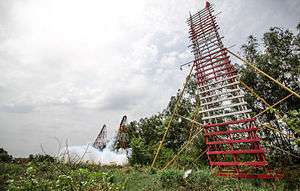
A Rocket Festival (Thai: ประเพณีบุญบั้งไฟ Prapheni Bun Bang Fai, Lao: ບຸນບັ້ງໄຟ Bun Bang Fai') is a merit-making ceremony traditionally practiced by ethnic Lao people throughout much of Isan and Laos, in numerous villages and municipalities near the beginning of the wet season. Celebrations typically include preliminary music and dance performances, competitive processions of floats, dancers and musicians on the second day, and culminating on the third day in competitive firings of home-made rockets. Local participants and sponsors use the occasion to enhance their social prestige, as is customary in traditional Buddhist folk festivals throughout Southeast Asia.[1]
Festival period : April - June (various local area ) The Festival most famous and widely know and have special program and specific local pattern of Bung Fai or Parade dance and Beautiful Bung Fai float in Thailand such as Yasothon The second weekend of May, Suwannaphum District, Roi Et The first weekend of June, Phanom Phrai District Roi Et Full moon of seventh month in Lunar year's calendar in each year. Not only found Bung Fai festival found in Isan or Northeasthern of Thailand and North of Thailand and Laos only,also has found some people who moved to Amphoe Sukirin Narathiwat has Bung Fai festival there too.
History
These Buddhist festivals are presumed to have evolved from pre-Buddhist fertility rites held to celebrate and encourage the coming of the rains, from before the 9th century invention of black powder. This festival displays some earthy elements of Lao folklore. Coming immediately prior to the planting season, the festivals offer an excellent chance to make merry before the hard work begins, as well as enhancing communal prestige, and attracting and redistributing wealth as in any gift culture.
Scholars study the centuries-old rocket festival tradition today as it may be significant to the history of rocketry in the East,[2] and perhaps also significant in the postcolonial socio-political development of the Southeast Asian nation states. Economically, villages and sponsors bear the costs in many locations in Laos and in northern Isan (northeast Thailand). The festivals typically begin at the beginning of the rainy season, in the sixth or seventh lunar months.
Anthropology Professor Charles F. Keyes advises, "In recognition of the deep-seated meaning of certain traditions for the peoples of the societies of mainland Southeast Asia, the rulers of these societies have incorporated some indigenous symbols into the national cultures that they have worked to construct in the postcolonial period.[3] Giving the "Bun Bang Fai or fire rocket festival of Laos" as one example, he adds that it remains "…far more elaborate in the villages than in the cities…."
Present day
Villages no longer stage "Bun Bang Fai" festivals on the scale of Yasothon's famous event. However, villages may have floats conveying government messages. They may also include fairs. In recent years the Tourism Authority of Thailand has helped promote these events, particularly the festivals in the Thai provinces of Nong Khai and Yasothon, the latter boasting the largest and most elaborate of these festivals.The Bun bang fai celebration in the past and up till now are not only in Yasothorn Province, but also in many other provinces around that city such as Roi Et, Kalasin, Srisaket, and Mahasarakham. In Suwannaphum of Roi Et Province is one the most magnificent and beautiful of Thailand's Bang Fai parades that is called "Bang fai eh" or "Bangfai ko" (Bang Fai Parade are decorated in the form of Thai traditional artwork or Line Thai).
Yasothon's festival
Since the March 1, 1972, separation of Yasothon from Ubon Ratchathani Province, with its world-famous Candle Festival, Yasothon's provincial capital has elaborately staged its now world-famous Rocket Festival annually over the Friday, Saturday, and Sunday weekend that falls in the middle of May.

Raw Friday (Thai: วันศุกร์ดิบ, Wan Sook Dip) features all-night performances of Mor Lam Sing (Thai–Isan: หมอลำซิ่ง), which continue intermittently into the early hours of Monday. Mor Lam Sing is a type of morlam that is very popular among the local Isan-Lao population. The performance goes on all night and the locals have great fun. Outsiders have a hard time understanding the humour, which is often rather bawdy.

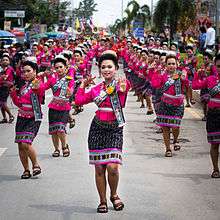
Saturday brings on the competitions for Hae Bangfai Ko (Thai: แห่บั้งไฟโก้). "Hàe" are street parades or demonstrations usually featuring traditional dance and accompanying musicians, typically with khaen (Thai: แคน), Gongs, Lao-Isan Klong Yao (Thai: กลองยาว), long drum), and an electric guitar, powered by an inverter and car batteries in a handcart that also mounts horn loudspeakers. Bangfai Ko are richly decorated rockets mounted on traditional but highly decorated oxcarts, or modern floats. Most but not all bold Bangfai Ko are for show and not actually capable of flight. Many sport the heads of Nāgas; if equipped with water pumps and swivels, they are actually capable of spitting on spectators.
The principal theme of any Hae Bangfai is the Phadaeng and Nang Ai legend (below), so many floats (or highly decorated oxcarts) also depict the couple and their retinue. Other modern themes present as well, as suggested by Keyes (ibid.) Participating groups compete for prizes within their categories. Hàe typically end in a wat, where dancers and accompanying musicians may further compete in traditional folk dance. All groups prominently display the names of their major sponsors.
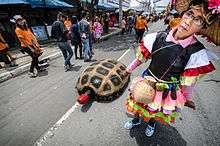
Recalling the fertility rite origins of the festival, parade ornaments and floats often sport phallic symbols and imagery.

Amid the festive atmosphere, dirty humour is widespread.
Festivities also include cross-dressing, both cross-sex and cross-generational, and great quantities of alcohol. Perhaps the most popular beverage, both because it is cheaper than beer and has a higher, 40-percent alcohol content, is a neutral grain spirit called Sura (Thai: สุรา), but more generally known as Lao Whiskey (Thai: เหล้าลาว, Lao lao) in Laos and Lao Khao (Thai: เหล้าขาว, white alcohol) in Thailand. Sato (Thai: สาโท), a brewed rice beverage similar to Japanese sake, may also be on offer; sweet-flavored sato may be as little as seven-percent alcohol, but it packs a surprising punch.
Sunday competition moves on to the launching of Bangfai, judged, in various categories, for apparent height and distance travelled, with extra points for exceptionally beautiful vapour trails Those whose rockets misfire are either covered with mud, or thrown into a mud puddle (that also serves a safety function, as immediate application of cooling mud can reduce severity of burns). While popular and entertaining, the festival is also dangerous, with participants and spectators alike occasionally being injured or even killed. On 9 May 1999, a Lan 120 kg rocket exploded 50 metres above ground, just two seconds after launch, killing four persons and wounding 11.[4]
Bang Fai (the rockets)
Jaruat (Thai: จรวด) is the proper term for rockets used as missiles or weapons, but Bang Fai (Thai: บั้งไฟ) skyrockets are gigantic black-powder bottle rockets. Tiny bottle rockets are so-called because they may be launched from a bottle. In the case of the similar appearing Bang Fai, also spelled 'Bong Fai' (Thai: บ้องไฟ), the 'bottle' is a bong (Thai: บ้อง), a section of bamboo Culm used as a container or pipe (and only colloquially as a pipe for smoking marijuana.)[5]
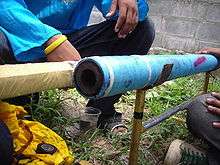
Related to the Chinese Fire Arrow, Bang Fai are made from bamboo bongs. Most contemporary ones, however, are enclosed in pvc piping, making them less dangerous by standardizing their sizes and black-powder charges (which contest rules require be compounded by the rocketeers, themselves). Baking or boiling a bong kills insect eggs that otherwise hatch in dead bamboo and eat it, inside out. Skipping this step may cause the bong to disintegrate and melt the PVC piping. Vines tie long bamboo tails to launching racks. The time it takes for the exhaust to burn through the vines (usually) allows a motor to build up to full thrust; then the tails impart in-flight stability. Ignition comes from a burning fuse or electric match.
Bang Fai come in various sizes, competing in several categories. Small ones are called Bang Fai Noi (Thai: น้อย). Larger categories are designated by the counting words for 10,000, 100,000 and 1,000,000: Meun (Thai: หมื่น) "Saen" (Thai: แสน) and the largest Bang Fai, the Lan (Thai: ล้าน). These counting words see use in many contexts to indicate increasing size or value. Lan in this context may be taken to mean extremely large as well as extremely expensive and extremely dangerous: Bang Fai Lan are nine metres long and charged with 120 kg of black powder. These may reach altitudes reckoned in kilometres, and travel dozens of kilometres down range (loosely speaking, as they can go in any direction, including right through the crowd). Competing rockets are scored for apparent height, distance, and beauty of the vapour trail (Thai: ไอ). A few include skyrocket pyrotechnics. A few also include parachutes for tail assemblies, but most fall where they may.
Nang Ai, Phadaeng, and Phangkhi

Nang Ai (Thai: นางไอ่), in full, Nang Ai Kham (นางไอ่คำ) is queen of the pageant and Phadaeng (ผาแดง) is her champion. She is famed as the most beautiful girl. He, an outsider, comes to see for himself, lavishes her with gifts and wins her heart; but must win a rocket festival tournament to win her hand. Unwittingly, he becomes part of a love triangle.

Phangkhi (ภังคี) and Nang Ai have been fated by their Karma (กรรม kam) to have been reborn throughout many past existences as soul mates (คู่สร้าง khusang, Lao-Isan สายแน่นนำเกี่ยว sai naen nam kiaw.) Stories about the couple, however, say they have not exactly been lovers: in many a past existence, she has been a dutiful wife, but would not yield an inch in an argument to anyone (ไม่ยอมใคร mai yom krai) and he only wanted to satisfy himself (เอาแต่ใจคัวเอง ow dtae jai dtua eng). She becomes fed up and prays never to be paired with him, ever again. Nang Ai is reborn as the daughter of Phraya Khom (พระยาขอม, (which means Lord Khmer; but even if her father was a Cambodian overlord, Nang Ai Kham is still the genuine article), while Phangki is reborn as the son of Phaya Nak, the Grand Nāga who rules the Deeps. (He is depicted in parades in the guise of a prince, riding alone, dogging the new pair.) Phangki isn't invited to the tournament, and Phadaeng's rocket fizzles. Nang Ai's uncle is the winner, so her father calls the whole thing off, which is considered to be a very bad omen, indeed. Pangkhii shape-shifts into a white squirrel to spy on Nang Ai, but she espies him and has him killed by a royal hunter. Pangkhii's flesh magically transforms into meat equal to 8,000 cartloads. Nang Ai and many of her countrymen ate of this tainted flesh, and Phaya Nak vows to allow no one to remain living who had eaten of the flesh of his son. Aroused from the Deeps, he and his watery myrmidons rise and turn the land into a vast swamp. Nagas personify waters running both above and below ground, and nagas run amok are rivers in spate: all Isan is flooded.

Phadaeng flees the rising flood with Nang Ai on his white stallion, Bak Sam (บักสาม Mr. Three), but she is swept off by a Naga's tail, not to be seen again. (Bak Sam is seen in parades sporting his stallion's equipage (อวัยวะเพศของม้า awaiyawa pet kong ma) that legend says dug a lick called Lam Huay Sam (ลำห้วยสาม, which may be seen to this day in Ban Sammo-Nonthan, Tambon Pho Chai, Amphoe Khok Pho Chai. The legend also tells that receding waters left behind the Nong Han Kumphawapi Lake of the Kumphawapi District marsh, which, too, may be seen to this very day.) Phadaeng escapes, but pines away for his lost love. His ghost then raises an army of the spirits of the air to wage war on the nagas below. The war continues until both sides are exhausted, and the dispute is submitted to King Wetsawan (ท้าวเวสสุวรรณ), king of the North, for arbitration. His decision: the cause of the feud has long since been forgotten and all disputants must let bygones be bygone.
The legend is retold in many regional variations, all of which are equally true for they relate events in different existences. One 3000-word poem translated to English[6] from this rich Thai-Isan tradition, "…is especially well known to the Thai audience, having been designated as secondary school supplementary reading by the Thai Ministry of Education, with publication in 1978. There is even a Thai popular song about the leading characters."[7] The original was written in a Lao-Isan verse called Khong saan, replete with sexual innuendo, puns, and double entendre.
Keyes (op. cit., p. 67, citing George Coedès[8]) p. 48, says "Phra Daeng Nang Ai" is a version of the Kaundinya, legendary founder of Funan; and Soma, the daughter of the king of the Nāga. Keyes also wrote that such legends may prove a valuable source of toponyms.[9]
The Myth of the Toad King
Almost everyone, native and visitor alike, will say Bang Fai are launched to bring rain, as in the Tourism Authority of Thailand link, below. However, a careful reading of the underlying myth, as presented in Yasothon and Nong Khai, implies the opposite: the rains bring on the rockets. Their version of the myth:
When the Lord Buddha was in his bodhisatta (Pali) (Thai: โพธิสัตว์, phothisat) incarnation as King of the Toads Phaya Khang Khok (Thai: พญาคางคก), and married to Udon Khuruthawip (Thai: อุดรคู่รู้ทวิป, Northern Partner-Knowing-Continent), his sermons drew everyone, creatures and sky-dwellers alike, away from Phaya Thaen (Thai: พญาแถน), King of the Sky). Angry Phaya Thaen withheld life-giving rains from the earth for seven years, seven months and seven days. Acting against the advice of the Toad King, Phaya Naga (Thai: พญานาค Phayanak), King of the Nāga (and personification of the Mekong) declared war on Phaya Thaen—and lost.
Persuaded by Phaya Naga to assume command, King Toad enlisted the aid of termites to build mounds reaching to the heavens, and of venomous scorpions and centipedes to attack Phaya Thaen's feet, and of hornets for air support. Previous attempts at aerial warfare against Phaya Thaen in his own element had proved futile; but even the Sky must come down to the ground. On the ground the war was won, and Phaya Thaen sued for peace.
Naga Rockets fired in the air at the end of the hot, dry season are not to threaten Phaya Thaen, but to serve as a reminder to him of his treaty obligations made to Lord Bodhisatta Phaya Khang Khok, King of the Toads, down on the ground. For his part Phaya Nak was rewarded by being given the duty of Honor Guard at most Thai and Lao temples.
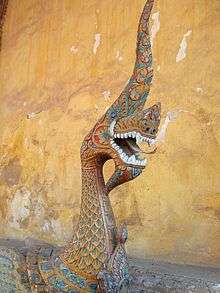

After the harvest of the resulting crops, Wow thanoo (Thai: ว่าวธนู, bow kite), man-sized kites with a strung bow, are staked out in winter monsoon winds. They are also called Túi-tiù (Thai: ตุ๋ยตุ่ย, singing kite), from the sound of the bowstring singing in the wind, which sing all through the night, to signal Phaya Thaen that he has sent enough rain.
All participants (including a wow thanoo) were depicted on murals on the front of the former Yasothon Municipal Bang Fai Museum, but were removed when it was remodelled as a learning centre.
An English-language translation of a Thai report on Bang Fai Phaya Nark Naga fireballs at Nong Khai gives essentially the same myth (without the hornets and wow) from Thai folk : The knowledge of Thai life-style . For an alternate English-language version, see Tossa, Wajuppa and Phra 'Ariyānuwat ; Phya Khankhaak, the Toad King: A Translation of an Isan Fertility Myth in Verse ; Lewisburg : Bucknell University Press London ; Cranbury, NJ : Associated University Presses ©1996 ISBN 0-8387-5306-X.
Etymology
- Bun (Lao: wikt:ບຸນ, Thai: บุญ ) merit (Buddhism)[10] is from Pali Puñña merit, meritorious action, virtue,[11] and Sanskrit पुण्य puṇya virtuous or meritorious act, good or virtuous works.[12]
- Bang (Lao: wikt:ບັ້ງ, Thai: บั้ง) (alternative spelling bong บ้อง,) is a cutting, specifically of bamboo.[10]
- Fai (Lao: ໄຟ, Thai: ไฟ), is Fire (classical element).[10]
- Prapheni Thai: ประเพณี), tradition,[10] is from Sanskrit परंपर parampara, an uninterrupted series, regular series, succession 'to be handed down in regular succession';[13] from Pali paraṁparā 7795 paraṁparā series, tradition.[14]
In popular culture
The 2006 Thai martial arts film, Kon Fai Bin, depicts the Rocket Festival. Set in 1890s Siam, the movie's hero, Jone Bang Fai ("Fireball Bandit"), is an expert at building the traditional bamboo rockets, which he uses in conjunction with Muay Thai martial arts to defeat his opponents.
Thai political protests in April 2010 similarly had Red Shirts firing bang fai in downtown Bangkok.[15]
See also
| Wikimedia Commons has media related to Rocket festivals in Northeast Thailand. |
- Chinese Fire Arrow for Flying Firelances, bamboo tubes stuffed with black powder; the tube was ignited and used as a flamethrower.
- Black powder
- Bottle rocket
- Gift economy
- Mysorean rockets — military weapons
- Phaya Naga
- Phi Ta Khon ghost festival — includes a rocket festival
- Phra Lak Phra Lam
- Skyrocket
- Thai folklore
References and notes
- ↑ Kammerer, Cornelia Ann and Tannenbaum, Nicola (1996). MERIT AND BLESSING: In Mainland Southeast Asian Comparative Perspective. New Haven (Connecticut): Yale University.: Southeast Asia Studies (Monograph 45). ISBN 0-938692-61-5.
- ↑ Frank H. Winter, curator of the Rocketry Division of the National Air and Space Museum in Washington D.C., "The 'Bun Bang Fai' Rockets of Thailand and Laos: Possible Key to determining the Spread of Rocketry in the Orient", in Lloyd H. Cornett, Jr., ed., History of Rocketry and Astronautics - Proceedings of the Twentieth and Twenty-First History Symposia of the International Academy of Astronautics, AAS History Series, Vol. 15 (Univelt Inc: San Diego, 1993), pp. 3-24.
- ↑ Keyes, Charles F. (1995). The golden peninsula : culture and adaptation in mainland Southeast Asia. Includes bibliographical references and index. Honolulu: (SHAPS library of Asian studies) University of Hawai'i Press. ISBN 0-8248-1696-X., p. 285.
- ↑ The Nation (Thailand), 1999-05-10, archive accessed 17 February 2012
- ↑ Sethaputra, So (1965). New Model Thai-English Dictionary. Bangkok, Thailand: So Sethaputra Press. ISBN 974-93509-8-7.
- ↑ Tossa, Wajuppa (1990). Phādāēng Nāng Ai : a translation of a Thai-Isan folk epic in verse. Includes bibliographical references. London and Toronto: Bucknell University Press. ISBN 0-8387-5139-3.
- ↑ Diller, Anthony. Review of: Wajuppa Tossa, Phadaeng Nang Ai
- ↑ Coedès, George (1968). The Indianized states of Southeast Asia, tr. by Susan Brown Cowing, ed. by Walter F. Vella. Honolulu: Research Publications and Translations Program of the Institute of Advanced Projects, East-West Center, University of Hawaii.
- ↑ Charles F. Keyes (keyes at u.washington.edu): Southeast Asian Studies, Vol 11, No. 4, March 1974, page 498, A Note on the Ancient Towns and Cities of Northeastern Thailand.
- 1 2 3 4 On-line Royal Institute Dictionary
- ↑ A comparative dictionary of Indo-Aryan languages
- ↑ Practical Sanskrit-English Dictionary
- ↑ Practical Sanskrit-English Dictionary
- ↑ paraṁparā 7795
- ↑ Pravit Rojanaphruk (21 April 2010). "Red shirts, soldiers ready". The Nation (Thailand). Archived from the original on 2014-07-04. Retrieved 4 July 2014.
... two home-made rockets (known in the Northeast as bang fai) attached to the bamboo poles were being set off every 10 minutes.
- Gray, Paul and Ridout, Lucy. Rough Guide to Thailand. Rough Guides, 2004. ISBN 1-84353-273-5.
- Tourist Authority of Thailand
Further reading
- Durrenberger, E. Paul (1983). "The Shan Rocket Festival: Buddhist and Non- Buddhist Aspects of Shan Religion" (PDF). Journal of the Siam Society. Siam Society. JSS Vol. 71.0h (digital). Retrieved October 10, 2013.
Anthropologists have repeatedly commented on the apparent contradictions between Buddhist and non-Buddhist aspects of lowland southeast Asian religions.... They differ in their interpretations. Some argue there are two religions which fulfill different functions ... while others argue there is only one religion which encompasses both aspects.... I shall address this larger question with reference to a particular Shan festival.
Videos
A video and a brief description about the Rocket Festival in Northeast Thailand (Issan, Esarn) can be seen from http://www.spatz-darmstadt.de (section "Asian Cultures" / "Ethnographic Videos" / "Thai,Lao Cultural Festivals" )